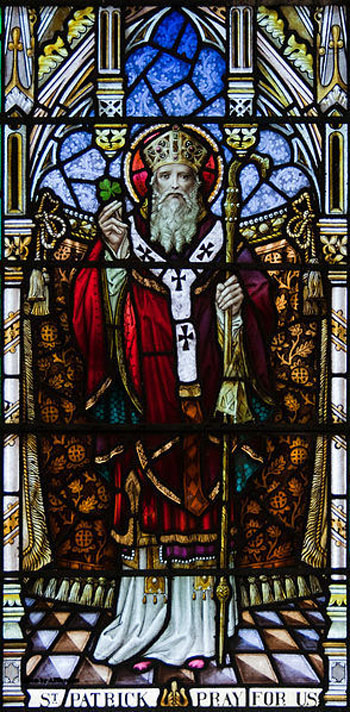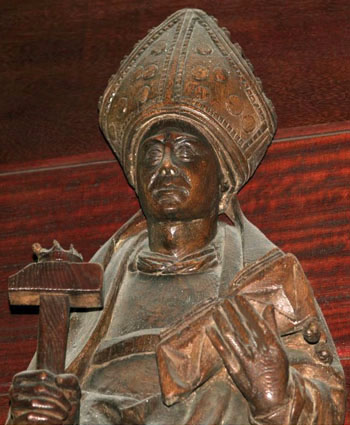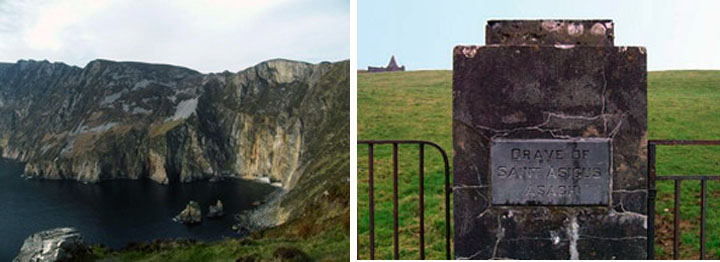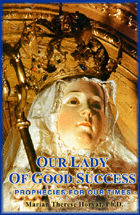Stories & Legends
 |
 |
 |
 |
 |
 |
 |
St. Patrick & the Robber Chief
We have a striking instance of the way in which St. Patrick infused the Catholic Faith and took immediate possession of souls for God in the conversion and penance of the robber chief MacKyle (or Macaldus), who later became Bishop of Man.
 This man and his band were the scourge of Ulster. Some of these robbers had been converted from their evil ways by the missionaries and, in consequence, their chief was very angry at St. Patrick.
This man and his band were the scourge of Ulster. Some of these robbers had been converted from their evil ways by the missionaries and, in consequence, their chief was very angry at St. Patrick.
When he heard that the Saint was to pass along a road in their area on a certain day, his first thought was to murder the priest whose teaching brought such shame on his own unholy trade. But, bad and bloodthirsty as he was, some sort of wild chivalry in his heart restrained him.
He, therefore, determined to make sport of the Saint and thus discredit him and his mission. With this design, MacKyle arranged that one of his band, named Garban, should lay down by the side of the woodland path, pretending to be dead.
Accordingly, Garban laid himself upon a bier and his companions, having covered him with a pall, entreated the Saint to bring the dead man to life.
St. Patrick, who knew by divine revelation all that had occurred, prayed over the man and, then, went on his way. When the fellow connivers approached and drew the pall from the face of Garban, they found that the jest had become earnest and the man was really dead.
In fear and trembling, the whole band followed the Saint and, falling at his feet, implored his pardon for their jest and begged him to restore the life of their friend. St. Patrick took pity on them and, at his prayer, the dead man arose. Then, he with his companions believed in Christ and were baptized.
Their leader MacKyle, then, came forward and confessed how it had entered into his mind to take away St. Patrick’s life. In the simplicity and energy of his repentance, he asked how he could atone for the crime he had considered and those of his past life.
When the Saint saw that he was dealing with one already transformed by grace and equal to any sacrifice, he imposed the most rigorous penance. At the command of St. Patrick, MacKyle went down to the sea shore. Patrick took a chain from a simple boat lying by the bank, flung it around the robber chief, secured the ends by a padlock and threw the key into the river.
![the island of Mann]](images_F-J/H139_Isle.jpg) Patrick ordered the robber to enter the boat and trust his course to Providence, with God alone as pilot. He told the robber: "Strive to maintain, with God's help, a spirit of true contrition. Pray without ceasing."
Patrick ordered the robber to enter the boat and trust his course to Providence, with God alone as pilot. He told the robber: "Strive to maintain, with God's help, a spirit of true contrition. Pray without ceasing."
He, then, unmoored the hide-covered canoe and it drifted down the river, out by the old seaport of Colpa and so into the open sea.
And the Lord, mindful of the faith of His servant Patrick and of the sublime sacrifice of the penitent, guided the boat until it was cast on the shore of the Isle of Man. Living there at this time were two Christians, Conindrus and Romulus, who are said to have been sent by St. Patrick to preach in that island. These men received and entertained the mysterious penitent and instructed him in the Catholic Faith.
In time he became Bishop of the Island of Man, and his name was held in great veneration both in the early Irish and British Churches.
A penitent Bishop
Another famous penitent was St. Assicus, who was a skilled coppersmith and silversmith. He was an early disciple of St. Patrick, who consecrated and appointed him Bishop of Elphin circa 450 AD. There, he founded a monastery, over which he presided.
 Now, it happened that this servant of God once told a lie. Entering into himself, he was filled with such bitter regret and such a spirit of penance for that sin that he fled the face of men. In shame he buried himself in solitude on Rathlin O'Birne Island in Donegal Bay, where for seven years he lived as a hermit, for he judged that he was no longer worthy to be a pastor and guide of souls.
Now, it happened that this servant of God once told a lie. Entering into himself, he was filled with such bitter regret and such a spirit of penance for that sin that he fled the face of men. In shame he buried himself in solitude on Rathlin O'Birne Island in Donegal Bay, where for seven years he lived as a hermit, for he judged that he was no longer worthy to be a pastor and guide of souls.
During these years his monks sought him sorrowing and at length discovered his hiding-place, which was a cave in a lonely valley. They besought him to return to that Church, which was his spouse and awaited him.
But the Bishop declared himself unworthy ever again to exercise his pontifical office since from his lips had proceeded a willful lie, which, coming from a priest, the sacred canons declare to be a sacrilege. Such are the words of the ancient chronicler.
Finally, the monks of Elphin persuaded him to return, but, being in poor health, he died on the journey back around the year 490 AD. He was buried where he died, near the village of Allintra in County Donegal. You can find his grave along the road from Ballyshannon to Donegal Town, just before the turn off to Rossnowlagh. His feast day is April 27 and he was named patron of coppersmiths and silversmiths.
The same intensity of faith that shrank from no sacrifices was seen in the fervor of those religious vocations which, even in the Apostle’s own time, made Ireland the wonder of the Christian world. In the History of the Church there has been no other example of a heathen nation that, in the lifetime of one man, sprang up into the maturity of the Christian life and became, in truth, what even from that time she was called, The Isle of Saints.




The account of the conversion is in the 9th century Book of Armagh, also known as the Canon of Patrick
When he heard that the Saint was to pass along a road in their area on a certain day, his first thought was to murder the priest whose teaching brought such shame on his own unholy trade. But, bad and bloodthirsty as he was, some sort of wild chivalry in his heart restrained him.
He, therefore, determined to make sport of the Saint and thus discredit him and his mission. With this design, MacKyle arranged that one of his band, named Garban, should lay down by the side of the woodland path, pretending to be dead.
Accordingly, Garban laid himself upon a bier and his companions, having covered him with a pall, entreated the Saint to bring the dead man to life.
St. Patrick, who knew by divine revelation all that had occurred, prayed over the man and, then, went on his way. When the fellow connivers approached and drew the pall from the face of Garban, they found that the jest had become earnest and the man was really dead.
In fear and trembling, the whole band followed the Saint and, falling at his feet, implored his pardon for their jest and begged him to restore the life of their friend. St. Patrick took pity on them and, at his prayer, the dead man arose. Then, he with his companions believed in Christ and were baptized.
Their leader MacKyle, then, came forward and confessed how it had entered into his mind to take away St. Patrick’s life. In the simplicity and energy of his repentance, he asked how he could atone for the crime he had considered and those of his past life.
When the Saint saw that he was dealing with one already transformed by grace and equal to any sacrifice, he imposed the most rigorous penance. At the command of St. Patrick, MacKyle went down to the sea shore. Patrick took a chain from a simple boat lying by the bank, flung it around the robber chief, secured the ends by a padlock and threw the key into the river.
![the island of Mann]](images_F-J/H139_Isle.jpg)
Arial view of the Isle of Man
He, then, unmoored the hide-covered canoe and it drifted down the river, out by the old seaport of Colpa and so into the open sea.
And the Lord, mindful of the faith of His servant Patrick and of the sublime sacrifice of the penitent, guided the boat until it was cast on the shore of the Isle of Man. Living there at this time were two Christians, Conindrus and Romulus, who are said to have been sent by St. Patrick to preach in that island. These men received and entertained the mysterious penitent and instructed him in the Catholic Faith.
In time he became Bishop of the Island of Man, and his name was held in great veneration both in the early Irish and British Churches.
A penitent Bishop
Another famous penitent was St. Assicus, who was a skilled coppersmith and silversmith. He was an early disciple of St. Patrick, who consecrated and appointed him Bishop of Elphin circa 450 AD. There, he founded a monastery, over which he presided.

The oldest known statue of St. Assicus, patron of coppersmiths and silversmiths
During these years his monks sought him sorrowing and at length discovered his hiding-place, which was a cave in a lonely valley. They besought him to return to that Church, which was his spouse and awaited him.
But the Bishop declared himself unworthy ever again to exercise his pontifical office since from his lips had proceeded a willful lie, which, coming from a priest, the sacred canons declare to be a sacrilege. Such are the words of the ancient chronicler.
Finally, the monks of Elphin persuaded him to return, but, being in poor health, he died on the journey back around the year 490 AD. He was buried where he died, near the village of Allintra in County Donegal. You can find his grave along the road from Ballyshannon to Donegal Town, just before the turn off to Rossnowlagh. His feast day is April 27 and he was named patron of coppersmiths and silversmiths.
The same intensity of faith that shrank from no sacrifices was seen in the fervor of those religious vocations which, even in the Apostle’s own time, made Ireland the wonder of the Christian world. In the History of the Church there has been no other example of a heathen nation that, in the lifetime of one man, sprang up into the maturity of the Christian life and became, in truth, what even from that time she was called, The Isle of Saints.

At left, Rathlin O'Birne Island in Donegal Bay where Assicus lived for seven years as a hermit; at right, the gateway to his tomb, in the distant left, in County Donegal

Adapted from William B. Morris, The Life of St. Patrick, Apostle of Ireland,
London: Burns and Oates, 1878, Appendix, pp. 232-236
Posted March 16, 2016
London: Burns and Oates, 1878, Appendix, pp. 232-236
Posted March 16, 2016






